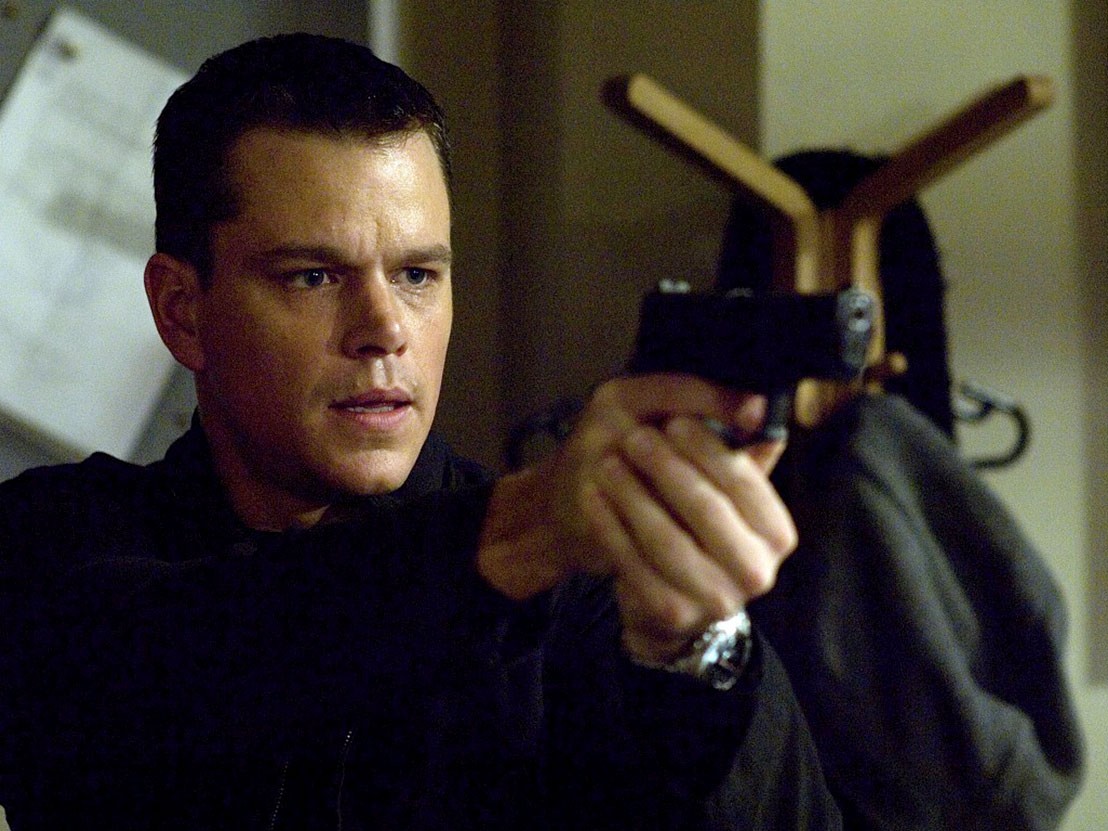
“Who has a safety deposit box full of money and six passports and a gun? Who has a bank account number in their hip?” If you want something done right, you’ve got to do it yourself; an adage that memory loss and scheming CIA puppet masters force Jason Bourne to live by. Words that suit the intentions, and achievements, of a game-changing trilogy that raised the bar, revitalised and redefined the modern espionage thriller.
The work of Matt Damon and directors Doug Liman and Paul Greengrass stands as a benchmark, a point of reference for suspenseful mainstream cinema with a desire to head back out into the cold, or at least benefit from its frosty edges. But in the late 1990s, the market saw the decline of James Bond, the rise of Ethan Hunt, innumerable Harrison Ford flicks and Austin Powers being all groovy, baby: were we really crying out for another super spy? The answer: absolutely.
The paranoia, fear and uncertainty which characterises post-9/11 America is embodied in a figure first seen in The Bourne Identity’s opening moments from the murky depths of the Mediterranean, a minute beacon emitting the faintest flicker of hope. Dragged from the sea, half-dead, two bullets lodged in his back and a microchip embedded under the skin, when discovered he is unable to recall his own name. There is no opening action spectacular. No close-ups of our hero pausing to fire-off unfeasibly corny one-liners. Female onlookers aren’t physically incapacitated by glancing upon his hot bod. How can we believe in a lead character suffering from crippling headaches and unexplained amnesia? The answer is simple: Matt Damon, a quintessential everyman.
The Western world was wounded, fragile in the wake of the Twin Towers attacks, and Jason Bourne, for all his hand-to-hand combat, map-reading skills, reckless driving and communication proficiency exhibits a vulnerability that makes him distinctly relatable. As did the actor’s relatively diminutive physique. Though in unquestionably good shape and as a tough as a coffin nail, his intellect, instincts and honesty supersede the physicality attributed to a traditional action hero. He doesn’t want to exploit women in any way, and he wants to express remorse for past sins. When he searches for the daughter of his first target at the conclusion of The Supremacy, he says: “When what you love is taken from you, you want to know the truth.”
Monosyllabic to a fault, his stoical demeanour thinly disguises his emotional trauma. Not least after the killing of his confidante, Marie (Famke Potente), while on a mission in Goa earlier in the same film. His reticence and lack of bravado is what makes him profound. Female characters across each of the films are substantially more than sexual objects. To a large extent they drive the narrative: Marie facilitates his escape; Pam Landy (Joan Allen) – in Supremacy and Ultimatum – is an unsung ally and female powerhouse in a workplace of useless, unscrupulous men; and Nicky Parsons (Julia Stiles) dutifully keeps the flame of his personal safety burning while retaining a cautious distance from first to last.
The overlapping of time structures knit the films together superbly and put faith in an audience’s ability to stitch together the pieces via flashbacks and a global trail of crumbs. In these compelling adaptations of Robert Ludlum’s novels, narrative and performance are economical. Superfluous action is always excised. A refreshing absence of bullet-dodging and unnecessary explosions sees a biro, a book, a magazine, or towel as Bourne’s domestic weapons of choice – no disappearing cars or gadgets. He uses payphones, luggage lockers and a dictaphone, a tool that proves mightier than the sword or a pistol in dispatching Brian Cox’s crooked section chief, Ward Abbott in Supremacy.
Brutal fight scenes are a pillar of each instalment and are choreographed with the grace of a ballet, every punch landing a blow with a viewer as well as adversaries. Essays could be written on the majesty of timing, camerawork and editing in three centrepiece car chases across Paris, Moscow and New York in Identity, Supremacy and Ultimatum respectively, but importantly there is always an objective in mind. They are, perhaps, a little indulgent, but point A leads to point B via a necessarily destructive, exhilarating route across each of the cities.
The continuity of plot is deeply satisfying and a welcome change from the unbelievable leaps of faith in so many comparable films. John Powell’s tremendous, instantly recognisable score further moulds an ever-moving story into a cohesive whole and as soon as Moby’s Extreme Ways kicks in over credits, we are left wanting more. With 2012’s The Bourne Legacy sitting as an awkward and much maligned elephant in the room, the curtain is set to fall on the latest, and much anticipated, Greengrass/Damon iteration. With Jason Bourne – the title underlining the main man’s presence this time around – fans of the franchise have high hopes. He won’t let them down.
Published 25 Jul 2016

Far from being a lean and exciting action caper, The Bourne Legacy wastes far too much time trying to justify its own existence.

Matt Damon is back and looking for answers in this high-octane franchise jumpstart.